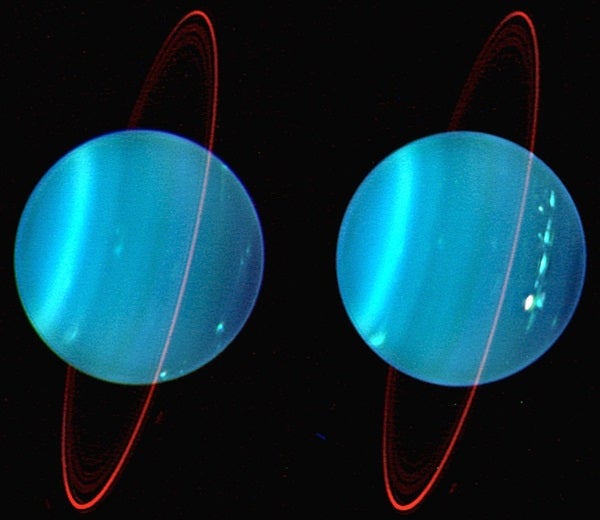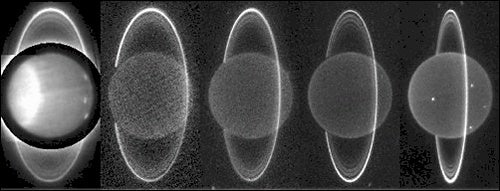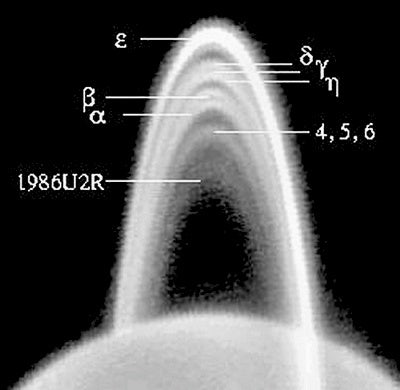In the southern hemisphere of Uranus, as summer draws to a close, methane storm clouds brew beneath the planet’s thick blue-green haze. New observations from two research teams using the Keck II 10-meter telescope atop Mauna Kea in Hawaii reveal unprecedented cloud behavior, fast winds, and a unique ring system.
Uranus has a reputation of being, well, dull. “When the Voyager 2 spacecraft flew by Uranus in 1986, it saw almost no discrete cloud activity,” said Heidi Hammel of the Space Science Institute in Boulder, Colorado. A thick, high-altitude haze masks cloud bands and storms, hiding weather systems from view, and some planetary scientists suggested the haze inhibited storm-forming convection deeper in the atmosphere. “Most astronomers decided that Uranus was a boring, static planet.”
Together with team leader Imke de Pater of the University of California, Berkeley, and Seran Gibbard of Lawrence Livermore National Laboratory, Hammel has been observing Uranus since 2000 with the second-generation Near Infrared Camera (NIRC2) on the Keck II Telescope.
A second team, led by Lawrence Sromovsky of the University of Wisconsin-Madison’s Space Science and Engineering Center, also imaged the planet with Keck II. The astronomers captured several Uranian weather oddities, including a big southern hemisphere storm feature that, during the course of several years, seesaws over 5° of latitude. “It’s weird behavior that hasn’t been recognized before on Uranus,” said Sromovsky. Such oscillations occur on Neptune, and more rapidly. “It is not surprising to see cloud features drifting in latitude, but our models don’t show these oscillations,” he explained. “We don’t know what makes it keep coming back to its starting point.”
Both teams reported their results today at the American Astronomical Society’s Division for Planetary Sciences meeting, held November 8 to November 12, in Louisville, Kentucky.
Part of what made the discoveries possible is the Keck II’s revolutionary adaptive optics (AO) system, which detects atmospheric changes that blur images and then distorts the telescope’s segmented mirror to correct them. “The detail provided by Keck’s AO system for the atmosphere and the rings of Uranus fundamentally changes the science we can achieve,” said Hammel.
“In terms of resolution, Keck can see better at infrared wavelengths than Hubble can see in visible light,” Sromovsky told Astronomy. “It is amazing that the amount of detail we can see from the ground with Keck far exceeds what we could see with Voyager during its relatively close pass by the planet.”
“I was actually present at the Voyager 2 encounter, and we struggled to find clouds,” said Sromovsky. “In all, we found eight trackable clouds.” The seventh planet’s dull reputation began to crack in 1998, when Eric Karkoschka made what Sromovsky calls a “quantum leap in seeing more cloud features” with infrared observations using the Hubble Space Telescope. The two Keck images Sromovsky released today, one for each Uranian hemisphere, contain 31 clouds, exceeding the total observed in all pictures obtained by the Voyager probe, the Hubble Space Telescope, and other telescopes up to the year 2000.
“Now we can really start to look at what’s going on in the atmosphere,” Sromovsky said.
The cloud features range from small to large, from dim and diffuse to sharp and bright, from rapidly evolving systems to those lasting for years. They include a narrow, 18,000-mile-long (29,000 kilometer) cloud complex in the northern hemisphere that is probably the largest group of atmospheric features ever seen on Uranus. This structure dissipated completely in just one month.
“The large, longer-lived cloud features of Uranus may be underpinned by giant hurricane-like vortices, as we’ve seen on Neptune,” Sromovsky explained. Energy for Earth’s weather ultimately comes from the Sun, but Uranus is 19 farther away than our planet. “There is very little temperature contrast and very little energy to drive the weather in Uranus,” Sromovsky said. How, then, can storm systems last for years? Sromovsky suggests the uranian atmosphere is “well lubricated,” posing little resistance to storms and, thus, dissipating less of their energy. “It has to be a low-friction environment.”
The Voyager 2 spacecraft made the first and only close-up observations of Uranus when it flew past the planet 18 years ago, when southern summer was then at its peak. The spacecraft observed faint, low-altitude cloud bands and a handful of discrete clouds. Scientists believe the bands and clouds form out of methane crystals condensing in the planet’s atmosphere, which is mostly hydrogen and helium. Astronomers predict the atmosphere surrounds a core of rock, surrounded by a slush of water, ammonia, and methane.
Uranus has extreme seasons because it spin axis lies nearly in the plane of its orbit. The beginning of autumn in the planet’s southern hemisphere — and the arrival of spring in the north — occurs only once every 84 Earth years as the planet lumbers around the Sun.
The northern hemisphere of Uranus is getting more and more sunlight, and by the year 2028, the planet’s north pole will point directly at the Sun, a complete reversal of the situation when Voyager flew by.
— Imke de Pater
The planet’s autumnal equinox, when its equator directly faces the Sun, comes in 2007. Now, for the first time, scientists are seeing high-altitude cloud activity — which indicates vigorous convection — in the planet’s southern hemisphere. Convection — the turbulent upward and downward movement of large air masses — creates clouds on Uranus just as it does on Earth.
One large cloud in the southern hemisphere showed a surprisingly bright core that remained visible even at 2.2 microns, a wavelength that doesn’t penetrate deep into the atmosphere due to absorption by methane. “We have never seen such vigorous convective activity in the southern hemisphere before,” said de Pater. “We think this might be a response to the changing geometry, because this region of Uranus now experiences both day and night, whereas during the Voyager flyby, it was always in sunlight.”
“Thus, this is the first time southern features have penetrated upward high enough to be detected at these wavelengths,” Hammel explained. She called the feature the “Fourth of July fireworks” because it surprised her team on July 4 and then faded below detectable levels within a week. Penetration of cloud activity to such altitudes was, she said, “unprecedented.” The amount of sunlight hitting different parts of the planet is changing as Uranus moves around the Sun. The changing radiation pattern alters the atmosphere’s heat balance. “This could be causing convection, or it could be turning off processes that had been inhibiting it,” Hammel said.
The de Pater team also reported the fastest winds ever recorded on Uranus. The winds, moving between 240 and 260 miles per hour (385 to 420 km/h), were measured in October 2003 on the northernmost parts of the planet.
The Uranus ring system is closing as the planet approaches its 2007 equinox, when it will be edge-on to observers on Earth. A faint sheet of dust cataloged as 1986U2R, seen in only a single Voyager image, has now revealed itself to de Pater’s team. Really a sheet of rocky debris, the ring — innermost of the 11 now known — is about 2,200 miles (3,500 km) wide and centered about 24,600 miles (39,600 km) from the planet’s center. Although a thousand times dimmer than the brightest ring — dubbed Epsilon — the inner ring is now visible because we see it more obliquely and more of the feeble sunlight it receives is reflected back to Earth.
Most surprising, though, is the group’s finding that boulder-size particles making up Uranus’ main rings are distributed in a single layer. “We had never seen such an odd configuration in other ring systems,” said de Pater. “Rings in other systems, like Saturn’s rings, are usually depicted as being many particles thick. Uranus’ ring system is unique in this respect.”












